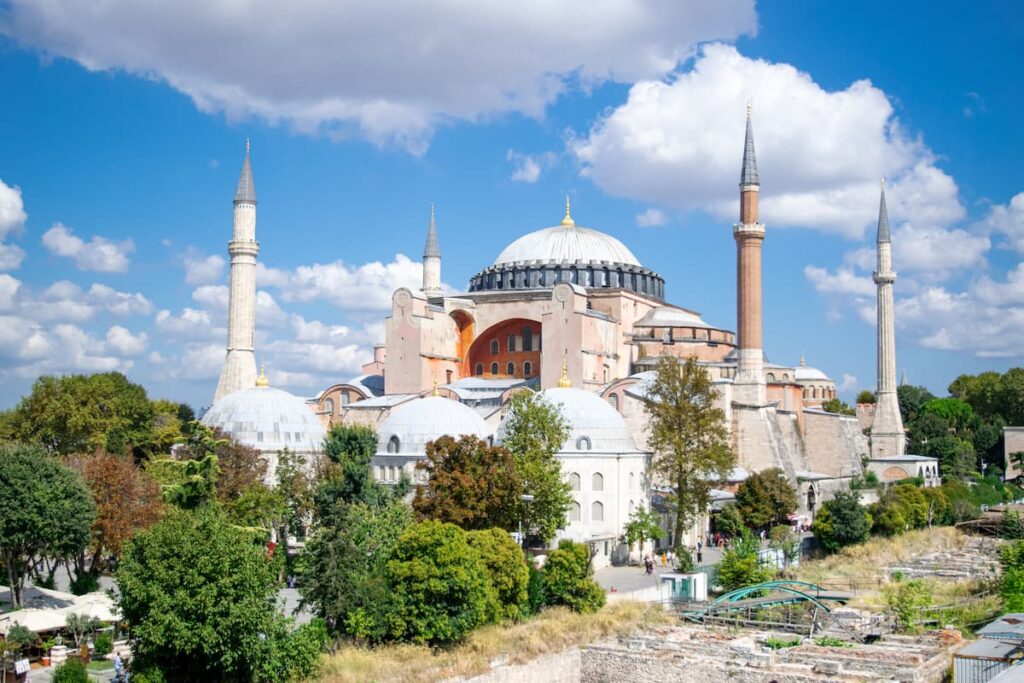Once the beating heart of the Byzantine Empire and later a symbol of Ottoman triumph, Hagia Sophia in Istanbul has stood at the intersection of religion, culture, and politics for nearly 1,500 years. Its enduring presence, layered with architectural brilliance and religious significance, tells the story of empires, faiths, and identities that have shaped modern Turkey and beyond.
From Pagan Temple to Sacred Megastructure
The current Hagia Sophia is the third sacred building to stand on its site, with its roots tracing back to a Roman pagan temple. The first church, known as the “Magna Ecclesia,” was inaugurated in 360 CE by Constantius II, son of Emperor Constantine. It was destroyed and replaced in 415 CE by Theodosius II, only to be reduced to ashes again during the Nika Revolt of 532 CE.
Justinian I seized the opportunity to rebuild. The emperor, known for his ambition and architectural vision, launched construction of what would become the most magnificent church of the Byzantine Empire. Built in just five years and financed through heavy taxation and seized property, the structure was meant to surpass even Solomon’s Temple. Though tales of Justinian exclaiming “I surpassed you, Solomon!” may be apocryphal, they reflect the monument’s symbolic weight in history.
The final building cost is estimated to be equivalent to $1.3 billion in today’s terms — more than the cost to rebuild Notre Dame Cathedral. Its completion, shortly after a city-wide revolt, marked a triumph not only of engineering but also of imperial resolve.
Religious Transformation and Preservation
Following the 1453 conquest of Constantinople, Sultan Mehmed II converted Hagia Sophia into a mosque. Rather than erasing its Christian past, Mehmed preserved much of its structure and Christian art. The building’s Greek name, meaning “Holy Wisdom,” remained unchanged. Over time, however, later Ottoman rulers, including Suleiman the Magnificent, began covering the Christian mosaics with plaster in accordance with Islamic norms.
For centuries, Hagia Sophia served as the grand mosque of the Ottoman Empire. Yet, after the establishment of the secular Republic of Turkey in 1923, Mustafa Kemal Atatürk transformed the site into a museum in 1935. This move sought to bridge East and West, and reflected Turkey’s secular pivot. Restoration projects during the 1930s unveiled the ancient Christian mosaics once hidden from view.
In 2020, the Turkish government reclassified Hagia Sophia as a mosque again. The decision drew international criticism, including from UNESCO and Pope Francis. Domestically, the conversion was met with little opposition. Since 2024, the building has operated as both a mosque and a partial museum, with tourists allowed to view its interior for a 25-euro fee, while its upper gallery remains open during prayer hours.
Endurance Through Empires and Earthquakes
Hagia Sophia has not only survived the fall of empires but also centuries of natural disasters and political upheaval. Built on solid rock, it has withstood powerful earthquakes — a fact attributed to its groundbreaking architectural design. The central dome, considered one of the marvels of ancient engineering, has undergone numerous restorations, including the most recent one launched in April 2025, which aims to increase the structure’s seismic resilience over a three-year conservation plan.
Myths and legends surround the building — from tales of divine mortars made of holy water and the Prophet’s saliva to rumors of secret relics hidden within its walls. These stories, whether historical or imagined, contribute to its sacred aura and public affection.
Symbol of Power and Contested Identity
To many, Hagia Sophia remains a symbol of conquest and legitimacy. Ottoman sultans, beginning with Mehmed II, performed their first Friday prayers there, cementing their rule. The act was as much political as spiritual, reinforcing continuity with the Roman legacy. Mehmed even adopted the title “Caesar of Rome,” an assertion of imperial succession that endured until the fall of the sultanate in 1922.
Today, its role continues to provoke debate. Urban scholars argue for a limited religious function—hosting only key Islamic prayers—to preserve its universal accessibility and cultural importance. Yet for many Turks, Hagia Sophia’s status as a mosque is a proud affirmation of national and religious identity.
Despite the debates, Hagia Sophia endures as a living museum of history, welcoming worshippers and tourists alike. Whether viewed as a church, a mosque, or a cultural icon, it stands as a monument to coexistence and resilience — a timeless beacon of “Holy Wisdom.”


